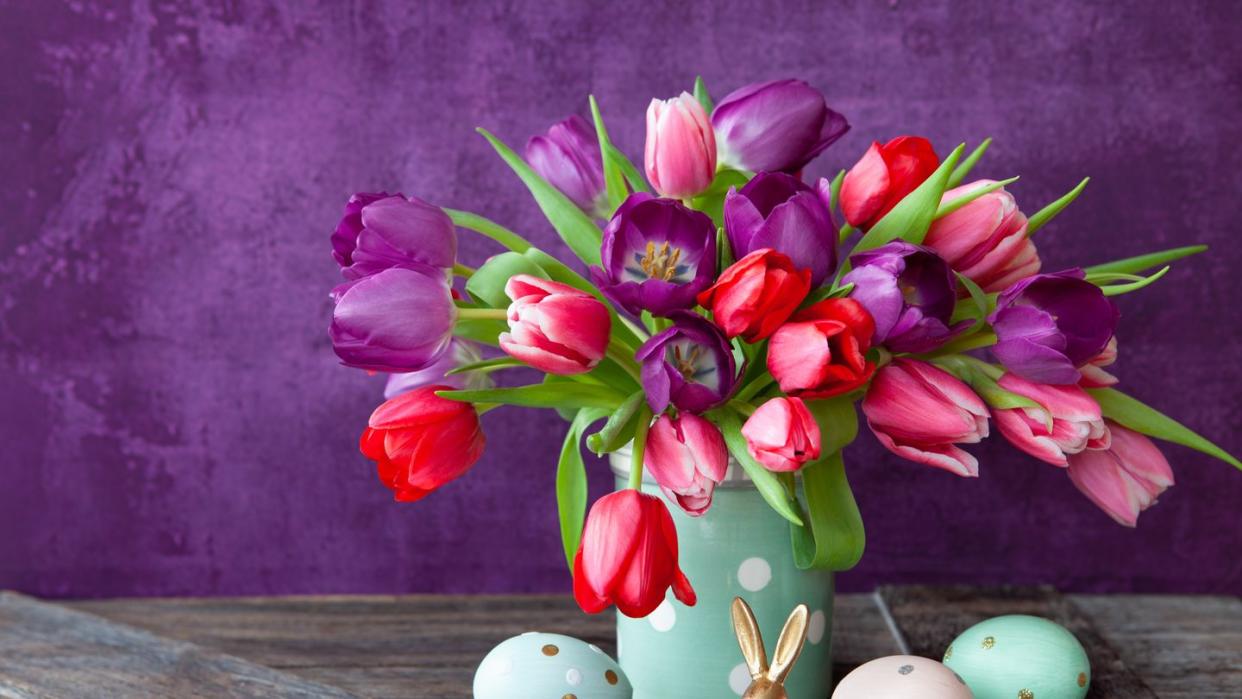These Are the Secret Meanings of the Most Popular Easter Flowers

For those who observe it, Easter marks the unofficial beginning of the spring season, when flowers finally begin to bloom and baby animals are born. Families may celebrate the holiday with lavish brunches and trips to church, while others may throw an outdoor Easter egg hunt or put together Easter baskets, stuffing them with an array of chocolates and other goodies.
But no matter how you enjoy the day, no celebration is complete without a beautiful bouquet of Easter flowers. They make for thoughtful hostess gifts and gorgeous seasonal centerpieces, and some of the most popular flowers even have hidden meanings that relate to the springtime season.
We spoke with Kourtney Selak, an Ithaca, New York-based florist and owner of Dirt Baby Farm all about the most popular Easter flowers. She explains why these blooms are so beloved and what they symbolize. Read on to learn everything you need to know about traditional Easter flowers and their secret meanings.
Daffodils
Widely beloved for their deer resistance, daffodils are also considered to be an emblematic Easter flower because they happen to bloom in the springtime.
“They are called 'Lent Lilies' in England,” Selak adds, because daffodils often tend to bloom right around Ash Wednesday.
Sweet Peas
While sweet peas bring color and fragrance to any flower arrangement, Selak tells us sweet peas are also “the birth flower of April.”
These popular beauties symbolize rebirth and are a seasonally appropriate addition to any Easter bouquet.
Daisies
Though often considered weeds due to their somewhat invasive nature, daisies are a significant Easter flower.
“Daisies are a symbol of purity and hope,” Selak says.
Considering that Easter celebrates rebirth, purity and hope are two very meaningful attributes for a bouquet during this time of year.
Hyacinths
“Hyacinths are some of the first flowers you'll see popping up in spring,” Selak says.
With their striking colors and lovely smell, you’ll want more of them around your home and in your bouquets of Easter flowers.
Irises
Because they bloom in the springtime, Selak explains, irises are extremely popular in springtime gardens, as well as Easter bouquets.
Dwarf irises generally bloom in early spring, most often being the first flower to bloom at winter’s end — another nod to the holiday’s prominent theme of rebirth.
Lilacs
“Lilacs will smell amazing in your bouquet,” Selak says.
In addition to its perfume-like scent, though, purple also represents atonement and grieving, making the lilac a poignant addition to your Easter flower arrangements.
Easter Lilies
True to their name, Easter lilies, Selak says, are “a traditional Easter flower representing rebirth and new beginnings.”
The flower is also mentioned several times in the Bible and is frequently depicted in religious art.
Lily of the Valley
Not to be confused with Easter lilies, the lily of the valley symbolizes a “return to happiness.” But, this bloom also has a deep connection to the season for other reasons.
“Lily of the valley is associated with the goddess Ostara,” Selak explains, “where the name Easter comes from.”
While you may not see these dainty flowers blooming in your garden until around May, they happen to be a longtime favorite for Easter bouquets.
Crocuses
“Crocuses are low-growing plants that are also some of the first flowers to pop out of the soil in spring,” Selak tells us.
They also symbolize rebirth, as some of spring’s first blooms.
Tulips
Because of their springtime charm, these colorful beauties are a go-to for Easter celebrations worldwide.
“Tulips are a favorite spring blooming bulb. So beautiful, they caused the 'tulip mania' in Holland in 1634,” says Selak.
Explore photos of Holland’s unbelievably charming tulip festival, and maybe consider booking a trip to celebrate Easter there next year!
Ranunculus
The elegant ranunculus “is delicate and comes in an array of colors, perfect for an Easter color palette,” Selak sas.
Also called a buttercup, the ranunculus happens to be a perennial flower, so if you decide to plant bulbs, they’ll grow back each year.
You Might Also Like

